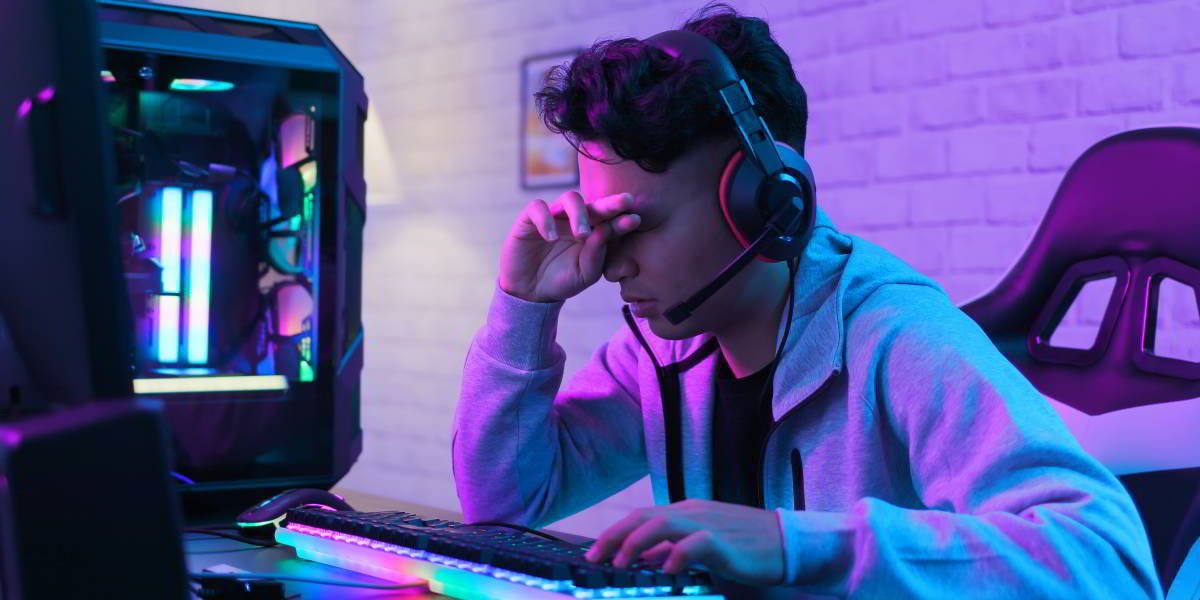

Gaming monitors may cause eye strain and fatigue due to blue light, flicker, and brightness issues. BenQ Eye-Care technology is here to help gamers stay healthy and comfortable.

The great hobby known as gaming has a reputation for being physically passive while mentally engaging, but in truth there exist very clear health implications for extended gaming sessions. While you’re free to game for as long as you want, please do keep in mind that your health may be affected. Clearly, eyesight gets implicated first, and manufacturers such as BenQ have been researching ways to mitigate or outright prevent any potential harm prolonged monitor use may cause. By the way, the trio of primary culprits with regards to gamer eye health and eye care are blue light, flicker, and ill-adjusted brightness.
Then again, the three aren’t exclusive to gaming displays. Most of us who enjoy gaming on PC or console also have jobs or go to school, which means a double whammy of sorts. We expose ourselves to the effects of monitors during the day, then in our free time as well. Not to mention all that smartphone indulgence throughout the day. All of these combined may lead to eye fatigue, dryness, blurry vision, headaches, and even trouble sleeping. So what’s being done about it? Let’s review each of the three major causes of gamer eye distress and how they can be at least lessened and moderated. A reminder: reactions to the three irritants discussed vary tremendously among individuals. Some people are very sensitive, others seemingly immune – only to find out years later that they were actually affected. In any case, this is not an authoritative medical science piece, as we’re not qualified to offer medical advice. Simply observations based on experience with technology.
Human eyes didn’t evolve with 144Hz gaming monitors and lush 4K with HDR in mind. It’s only in the last century that blue light has been a recurring figure in human life, and especially over the last four decades. We normally don’t see blue light, known for the way it appears on the light spectrum. With wavelengths too short for human vision, blue light remains a by-product of current display technology. TVs, monitors, smartphones, tablets, laptops – think of a screen, and think blue light. Since our eyes were not meant to handle blue light, extended exposure to it irritates tissues and structures in the eyes and affects our brains in many ways that are still being researched. While it’s likely none of these effects are overly dramatic, they may cause discomfort among many people.
There’s no way currently to totally eliminate blue light emissions, but filtering technology has been around for a while. Just like you can get glasses with blue light filters, manufacturers can apply screen layers that dissipate or block short wavelength blue light without compromising image quality.
Of course, those layers require additional precision processes and a longer production cycle, so you’re not going to get them with cheapo monitors, but rather with brands that pay attention to user health and comfort.
Digital displays like gaming monitors flicker because what we perceive as video or animation is actually frames splashed on the screen at very fast speeds. Whether you have a 60Hz or a 144Hz doesn’t matter, you’re seeing the flicker even if you don’t realize it. Flicker appears to be more subjective than blue light. Some people literally spot frames updating at anything under 60Hz, while the overwhelming majority never notice actual flicker even at 24Hz. Regardless, even if we don’t see flicker, we process it. Do that for long periods of time and the constant focus-refocus your eyes do with each flicker could add up to induce fatigue.
Once more, there’s really no way to avert flickering altogether. Instead, good monitor manufacturers with an awareness of the issue invest in good technology that properly syncs frame refresh and in screen materials that dampen the outward effect. A hastily synced monitor will have inconsistent flickering that’s a lot more annoying than a high speed, meticulously clocked monitor. Likewise, a screen with cheap materials and no flicker protection strata can’t hope to compete with a BenQ Eye-Care model.
Static brightness and color temperature may not be good for you over extended periods of monitor use. As ambient light conditions change wherever you may be, if your monitor stays at fixed brightness and color settings your eyes may find it hard to juggle the discrepancy between monitor and environment. Brightness that looks great when it’s sunny outside could be irritating if the weather turns cloudy, and of course daytime and nighttime usage conditions differ greatly. Natural light and artificial illumination similarly interact in totally different ways with your display.
Reactive brightness and color adjustment technology helps overcome this challenge to a great extent. Monitors with embedded smart sensors automatically alter brightness, contrast, and color parameters to best suit ambient light conditions, minimizing the likelihood of eye fatigue and discomfort. The technology keeps getting better, now encompassing HDR content. You can always turn it off if you’d like, but why would you?
While we do recommend taking breaks, and BenQ Eye-Care tech even has break reminders if you want those, we also know how fun “one more turn” can be. So we won’t lecture you on spending time in front of screens, which is unavoidable for most people now anyway. Rather, we’ll urge you to choose displays from brands openly committed to and clearly aware of eye health.
{{title}}
We will notify you when we have more.
We will send you an email once the product become available.Your email will not be shared with anyone else.
Sorry, our store is currently down for maintenance.We should be back shortly. Thank you for your patience!